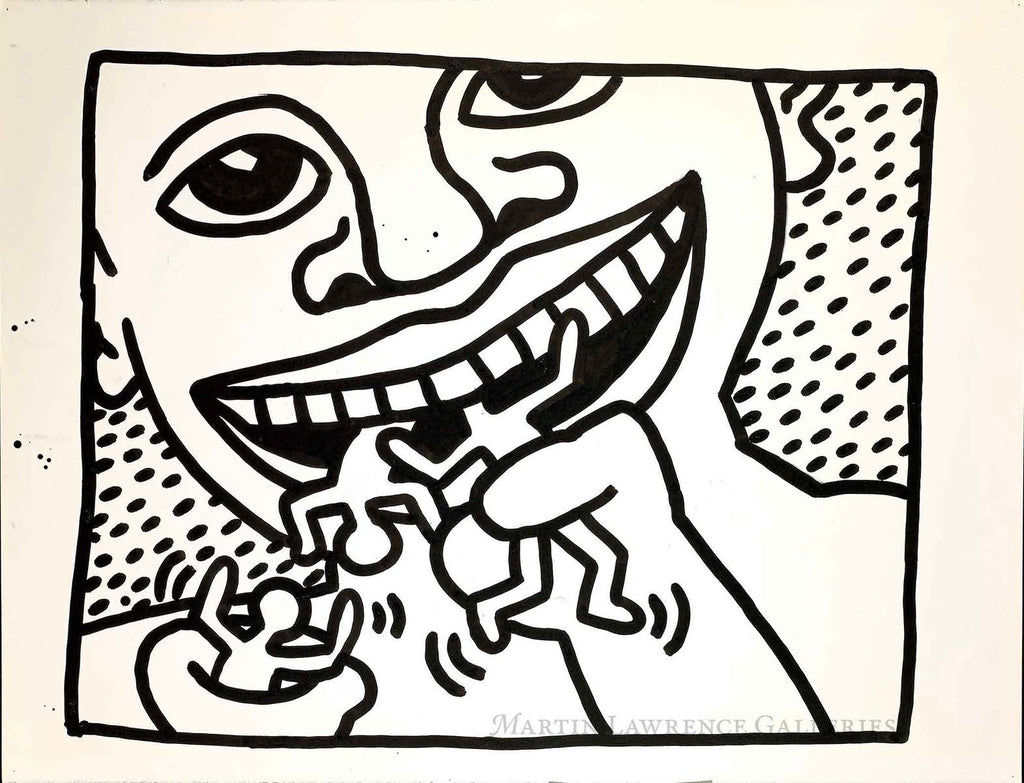Upload a photo of your space
For best results we recommend marking 10 inches on your wall with tape to get a sense of scale. Make sure to have the floor visible in the photo.






About the Work
"Untitled (Cannibal)" is a sumi ink on paper created by Keith Haring in 1982. The artwork is signed and dated verso 'SEPT.21 - 82 + K. Haring'. The image size is 38 x 50" and the artwork is framed in a custom, closed-corner, gold-leaf frame. The artwork ships framed.
By the early 1980s, Haring had begun to move beyond his famous subway drawings, creating large-scale works that confronted the anxieties of modern life with an unprecedented combination of immediacy and mythic force.
Executed on September 21, 1982, this monumental sumi ink drawing — colloquially titled "Cannibal" — is a powerful example of Haring’s early mastery, a time when his language of bold lines and simplified figures achieved both graphic clarity and psychological depth.
Created in deep black sumi ink on a commanding sheet measuring 38.5 x 50 inches, the work depicts a single monumental face, its mouth stretched open in a consuming frenzy. From the upper left corner, this voracious figure lunges diagonally across the composition, its enormous jaws devouring smaller human forms. One victim is already halfway inside the mouth, while two more are held aloft — one with its head moments from being bitten off. The creature’s eyes are rendered as vacant voids, imparting an eerie, deadened expression that heightens the sense of nightmare inevitability. The power of this image lies in the tension between Haring’s instantly legible vocabulary — thick lines, simplified anatomy — and the disturbing violence of the scene. This duality is at the heart of Haring’s most compelling work: symbols that read as almost childlike, yet carry the weight of profound existential dread.
1982 was a formative year for Haring. Having recently debuted at Tony Shafrazi Gallery and established his presence in New York’s downtown art scene, he was also grappling with the growing specter of the AIDS epidemic, the pervasiveness of media consumption, and the dehumanizing forces of political and economic systems. The subject matter of "Cannibal" resonates with multiple layers of reference. As classical allegory, it recalls Saturn devouring his children — a timeless symbol of power destroying innocence. As Dantean Vision it evokes the medieval depictions of Satan in 'Inferno' chewing the arch-traitors — Cassius, Judas, and Brutus — and suggests an eternal punishment meted out by a monstrous authority. As Kafkaesque anxiety, this dehumanized face and deadened eyes evoke a mechanistic appetite, a bureaucratic horror where the individual is consumed without meaning. And finally, as a Boschian nightmare, it echoes Hieronymus Bosch’s apocalyptic scenes, transforming the familiar into something uncanny and grotesque. This combination of mythic archetype and contemporary unease is what makes the work so powerful. It is not merely a depiction of violence but a reflection on the devouring structures — political, cultural, biological — that defined Haring’s generation.
This imagery bridges ancient allegory and modern anxiety in a way that situates it among the most significant social commentaries of Haring’s oeuvre. While many of Haring’s most iconic images celebrate joy and collective energy, "Cannibal" demonstrates his equally powerful capacity to evoke dread and moral critique — qualities that deepen any serious collection of contemporary art. 1982 marks the moment when Haring’s work transitioned from underground phenomenon to global conversation, resonating with the fears and contradictions of an era grappling with disease, surveillance, and violence. "Untitled (Cannibal)" is a profound statement on power and vulnerability — one that continues to speak with unsettling force to our own time.
About the Artist
Keith Haring was a social activist and artist who wasn’t afraid to depict and publicize controversial topics such as war, sexuality, life, and death with his art. Haring used New York City - the walls, stations, and buildings - as his canvas, creating masterpieces for the public eye. His signature cartoon style combined his outspoken political and social activism place Haring amongst the legends in the art world. Born May 4, 1958, in Reading, Pennsylvania, Haring grew up fascinated by the cartoon art of Walt Disney, Charles Schultz, and even Dr. Seuss. Haring’s father also drew cartoons as a hobby in his free time, inspiring a young Haring to perhaps make his own one day. Eventually, as a grown man, he moved to New York City to enroll at the School of Visual Arts. It is there Haring found his artistic peers and social niche and became acquainted with Jean-Michel Basquiat and Kenny Scharf, among other individuals in the underground art scene.
Please utilize the AR experience in a well-lit room.
Scan the room for surface detection.

Artwork will place in your room.
Using your fingers, align the horizontal white line
with your floor.

Double tap the artwork to scale to 100% size
and pinch to move on the screen.









